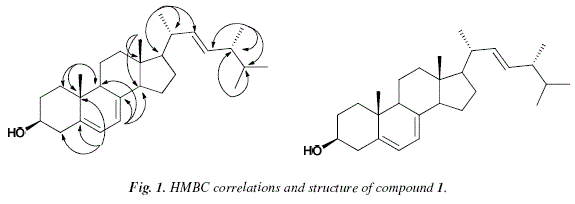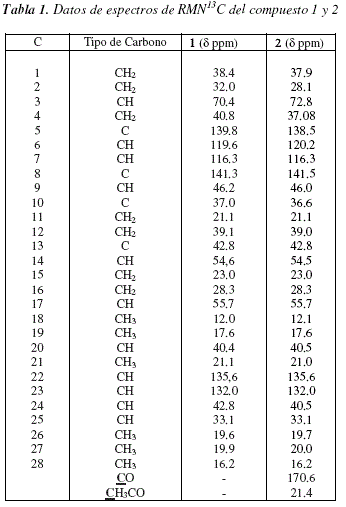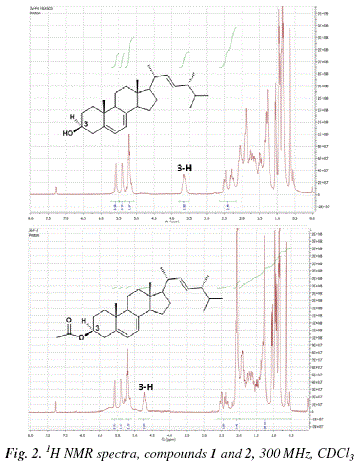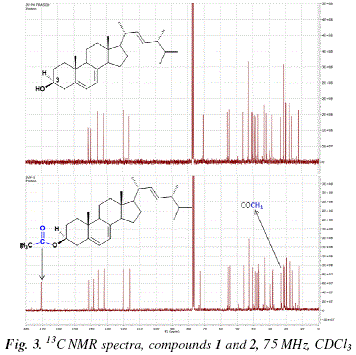Revista Boliviana de Química
versión On-line ISSN 0250-5460
Rev. Bol. Quim vol.32 no.4 La Paz nov. 2015
ARTICULOS ORIGINALES
Ergosterol from the mushroom laetiporus sp.; isolation and structural characterization
Aislamiento y caracterización estructural de ergosterol del hongo Laetiporus sp.
Miguel Martinez1, Sergio Torrez Alvarez2, Michelle Geraldine Campi1, José A. Bravo3, José L. Vila*,2
1School of Natural and Exact Sciences, Laboratorio de Análisis de Recursos Vegetales LARV, Área Fitoquímica, Universidad Nacional de Asunción UNA, Av. Mcal López 3492 c/ 26 de Febrero, Campus Universitario, phone 59521585 600/01, San Lorenzo, Central, Paraguay, facen@facen.una.py
2Department of Chemistry, Laboratorio de Síntesis y Hemisíntesis, Instituto de Investigaciones en Productos Naturales IIPN, Universidad Mayor de San Andrés UMSA, P.O. Box 303, Calle Andrés Bello s/n, Ciudad Universitaria Cota Cota, phone 59122792238, La Paz, Bolivia, joselu62@hotmail.com
3Department of Chemistry, Laboratorio de Fitoquímica, Instituto de Investigaciones en Productos Naturales IIPN, Universidad Mayor de San Andrés UMSA, P.O. Box 303, Calle Andrés Bello s/n, Ciudad Universitaria Cota Cota, phone 59122792238, La Paz, Bolivia, joseabravo@outlook.com
*Corresponding author: joselu62@hotmail.com
Abstract
Laetiporus sp. a mushroom growing on species of Eucalyptus sp in Piribebuy city, Cordillera department, Paraguay, was submitted to extraction and crystallization procedures to obtain the main secondary metabolite, ergosterol. To the best of our knowledge, this is the first report on ergosterol in this genus. The structural characterization was achieved by means of NMR techniques, namely 1H, 13C, COSY H-H, HMQC and HMBC.
Keywords: Ergosterol, Laetiporus, NMR
Resumen
Del hongo Laetiporus sp. se aisló ergosterol, que fue identificado a través de técnicas espectroscópicas de RMN-1H, RMN-13C, COSY H-H, HMQC y HMBC, esta especie fue colectada en la ciudad de de Piribebuy del Departamento de Cordillera de la República del Paraguay. Una investigación bibliográfica reveló que este el primer reporte de ergosterol en este género.
INTRODUCTION
The use and research of mushrooms has a recent history in the western civilization: Europe, North and South America; in contrast, in Asia, there is a long tradition of their use and of their investigative approach [1]. There are a grand number of reports on the secondary metabolites contents of mushrooms. The structural diversity of the metabolites of mushrooms has awakened a remarkable interest from the chemical and pharmacological stand point [1,2].
The mushrooms of the genus Laetiporus sp. grow in all type of forests. They can usually be found over the surface of dead trees. The mushroom studied and reported here is used as food; it has the reputation as cure for intestinal disorders [3].
Ergosterol is a common constituent of higher plants; however, it's present in lichens and fungi. The biological activities spectrum of ergosterol includes: anticancer [4], antioxidant [5], anticoagulant [6], and the involvement in the active expression of the specific defense gene [7]. In the present paper we report the isolation and identification of ergosterol from the mushroom Laetiporus sp. collected in in Piribebuy city.
RESULTS AND DISCUSSION
Laetiporus sp. is a mushroom growing on the trunk of species of Eucalyptus sp. It was collected in Piribebuy city, Cordillera department, Paraguay. The ethanolic crude extract (95%) was treated with acetone and methanol. This treatment gave rise to pure crystals of compound 1.
Some 30 mg of 1 were dissolved in CDCl3 and were submitted to 1D and 2D NMR analyses. The structure after its elucidation was confirmed by acetylation of 1 to give rise to the 3-OAc derivative (2) and by comparison of the 1H and 13C NMR spectra with data from the literature. Compound 1 showed in its 1H NMR spectrum, signals of aliphatic protons, namely, methylenes and six fine singlets of methyl. The 13C NMR spectrum showed 28 signals for 28 carbons, 6 methyls, 7 methylenes, 11 methines and 4 quaternaries. The HMBC spectrum shows correlation peaks for methyl protons at ![]() 0.83 with
0.83 with ![]() 33.1,
33.1, ![]() 42.8 and the methyl at
42.8 and the methyl at ![]() 19.6. Protons at
19.6. Protons at ![]() 0.93 ppm correlate with methine carbons at
0.93 ppm correlate with methine carbons at ![]() 42.8,
42.8, ![]() 33.1 and
33.1 and ![]() 132. The methine proton at
132. The methine proton at ![]() 5.2 correlates with methine at
5.2 correlates with methine at ![]() 42.8 and
42.8 and ![]() 40.4. The methyl protons at
40.4. The methyl protons at ![]() 1.05 are remotely coupled with methines at
1.05 are remotely coupled with methines at ![]() 135.0,
135.0, ![]() 40.4 and
40.4 and ![]() 55.7. The vinyl protons at
55.7. The vinyl protons at ![]() 5.6 and
5.6 and ![]() 5.4 couple with quaternaries at 141.3 ppm y 139.8 ppm respectively. The protons of the methyl group at
5.4 couple with quaternaries at 141.3 ppm y 139.8 ppm respectively. The protons of the methyl group at ![]() 0.96 correlate with methylene at
0.96 correlate with methylene at ![]() 38.4, the methine at
38.4, the methine at ![]() 45.2 with quaternaries at
45.2 with quaternaries at ![]() 37.0 and
37.0 and ![]() 139.8. The COSY H-H spectrum allows observing mainly the vicinal coupling of H6 and H7, and H22 and H23. All these spectral features conduct to the structural proposal of compound 1 (Fig. 1). The carbon chemical shift values are in accordance to the published data for ergosterol [8].
139.8. The COSY H-H spectrum allows observing mainly the vicinal coupling of H6 and H7, and H22 and H23. All these spectral features conduct to the structural proposal of compound 1 (Fig. 1). The carbon chemical shift values are in accordance to the published data for ergosterol [8].
Compound 1 was acetylated to afford compound 2. The downfield shift of the signal of H-3 (![]() 3.65) until (
3.65) until (![]() 4.88, see Fig. 2), confirms the hydroxyl-bearing condition of C-3 in 1. Compound 2 shows in the 13C NMR spectrum, the existente of a carbonyl at 170.6 ppm, as well as the acyl methyl at
4.88, see Fig. 2), confirms the hydroxyl-bearing condition of C-3 in 1. Compound 2 shows in the 13C NMR spectrum, the existente of a carbonyl at 170.6 ppm, as well as the acyl methyl at ![]() 21.4. The 1H NMR spectrum of 2 exhibits the signal at 5 2.1 ppm corresponding to a mehtyl whose protons correlate to the
21.4. The 1H NMR spectrum of 2 exhibits the signal at 5 2.1 ppm corresponding to a mehtyl whose protons correlate to the ![]() (170.6 ppm) in the HMBC. This correlation permits corroborating the presence of the acetyl group at C-3 in 2 and thus the OH group at C-3 in 1 (Fig. 3). See Table 1 for the 13C chemical shifts.
(170.6 ppm) in the HMBC. This correlation permits corroborating the presence of the acetyl group at C-3 in 2 and thus the OH group at C-3 in 1 (Fig. 3). See Table 1 for the 13C chemical shifts.
EXPERIMENTAL
General
Solvents for crystallization were acetone and methanol p.a. Monitoring of compounds was done through TLC Silica gel 60 F254,TLC Merck. NMR spectra were run in a Bruker 300 MHz, AV300 using CDCl3 and TMS as internal standard.
Vegetal material
The mushroom Laetiporus sp., was collected in Piribebuy city, Cordillera department, Paraguay, coordinates were latitude 25°,29'49.3"S y longitude 56°57'25.0"O on April 30, 2015 at 200 m.a.s.l. The total amount of collected material was 7 kg. The source was trunk of trees of the species Eucalyptus sp. The classification of the genus was done in handmade slices for the visualization of microscopic features like: hyfal system, esperes and espores; and macroscopic characteristics like size, color, context, hymenia. These observations were compared to bibliographic reported data for the genus. A voucher specimen is deposited at the FACEN-Herbarium, Paraguay, under the code HFACEN45.
Extraction and isolation
7 kg of Laetiporus sp. were submitted to mechanical pressure inside a cylindrical recipient after adding ethanol 95% until disintegration of the sample using a wood tool. The first extraction by maceration lasted 30 days, under agitation and applying mechanical pressure every two days. In addition 5 extractions were made, one every 8 days under agitation. The extracts were concentrated at reduced pressure. The crude extract obtained was yellow and viscous. The crude extract was rinsed with acetone at 15 °C many times to afford a white precipitate, which was re-crystallized with methanol. The yield was 0.006 % . 30 mg of the white crystals were submitted to NMR analyses.
Acetylation
Crystals of 1 (50.1 mg) were dissolved in 2 mL of acetic anhydride. Pyridine was added (three drops). Reaction time of this mixture was 24 hs. After this period, 50 mL of distilled water was added to provoke the apparition of a white precipitate corresponding to compound 2. The precipitate was filtered and dried. 30 mg of 2 were dissolved in CDCl3 and submitted to NMR analyses.
Compound1
Ergosterol: 13C NMR (75 MHz, CDCl3) 5 38.4, 32.0,70.4, 40.8, 139.8, 119.6, 116.3, 141.3, 46.2, 37.0, 21.1, 39.1,
42.8, 54,6, 23.0, 28.3, 55.7, 12.0, 17.6, 40.4, 21.1, 135,6, 132.0, 42.8, 33.1, 19.6, 19.9, 16.2
Compound2
3-acetylergosterol: 13C NMR (75 MHz, CDCl3) 5 37.90, 28.10, 72.83, 37.08, 138.53, 120.20, 116.29, 141.53, 46.02, 36.64, 21.11, 39.01, 42.80, 54.51, 22.99, 28.30, 55.68, 12.05, 17.6, 40.5, 21.01, 135.57, 131.96, 40.46, 33.08, 19.65, 19.96, 16.15, 170.6,21.4
CONCLUSION
Ergosterol (ergosta-5,7,22-trien-3![]() -ol) and steroids of relative structures of ergosterol have been previously reported: ergosterol peroxide (5,8-epidioxy-5
-ol) and steroids of relative structures of ergosterol have been previously reported: ergosterol peroxide (5,8-epidioxy-5![]() ,8
,8![]() -ergosta-6,22-dien-3
-ergosta-6,22-dien-3![]() -ol) from Inonotus hispidus (Bull.: Fr.) P. Karst and several other mushrooms [1,9,10]; Inonotus obliquus [1,11,12]; Paecylomices tenuipes [1,13]; Tricholoma populinum [1,14,15]; Ganoderma applanatum [1,16]; Polyporus umbellatus [17]; ergosterol itself from Grifola frondosa [1,18]; 5
-ol) from Inonotus hispidus (Bull.: Fr.) P. Karst and several other mushrooms [1,9,10]; Inonotus obliquus [1,11,12]; Paecylomices tenuipes [1,13]; Tricholoma populinum [1,14,15]; Ganoderma applanatum [1,16]; Polyporus umbellatus [17]; ergosterol itself from Grifola frondosa [1,18]; 5![]() -ergosta-7,22-dien-3
-ergosta-7,22-dien-3![]() -ol from Ganoderma applanatum [1,16]. The mushroom Laetiporus sp. has been investigated, ergosterol (ergosta-5,7,22-trien-3
-ol from Ganoderma applanatum [1,16]. The mushroom Laetiporus sp. has been investigated, ergosterol (ergosta-5,7,22-trien-3![]() -ol) was extracted and crystallized. This is the first time that ergosterol is reported in this genus.
-ol) was extracted and crystallized. This is the first time that ergosterol is reported in this genus.
ACKNOWLEDGEMENTS
The authors want to thank Dr. Ana María González (Argentina) and Mr. Carlos Espínola Ruíz (Paraguay) for their contribution in collecting the mushroom. Lic. Claudia Mancuello for participating in the processing of the vegetal material. Dr. Yonny Flores, Department of Chemistry - UMSA, for NMR spectra.
REFERENCES
1. Lindequist, U., Niedermeyer, T.H.J., Jülich, W.D. J. 2005, EvidBased Complement AlternatMed., 23, 285. [ Links ]
2. De Bernardi, M., Garlas C.L., Vidari, G., Vita, F.P. 1989, Rev. Latinoam. Quím., 20, 57. [ Links ]
3. Moreno, G., Garcia, J., Zugaza, A. 1986, La guía Incafo de los hongos de la península ibérica, INCAFO, Tomo I y III, Madrid. [ Links ]
4. Kang, J.H., Jang J.E., Mishra, S.K., Lee, H.J., Nho, C.W., Shin, D., Jin, M., Kim, M.K., Choi, C.S., Hyun S.O. 2015, Journal of Ethnopharmacology, 173, 303. [ Links ]
5. Keller C., Maillard M., Keller J., Hostettmann K., 2002, Pharm. Biol. 40, 518. [ Links ]
6. Okamura, T., Takeno, T., Dohi, M., Yasumasa, I., Hayashi, T., Toyoda, M., Noda, H., Fukuda, S., Horie, N., Ohsugi, M., 2000, 89, 474. [ Links ]
7. Zhang, Y.Q., Rao, R. 2010, Virulence, 1, 1. [ Links ]
8. Tao, R., Wang, C.Z., Kong, Z.W. 2013, Molecules, 18, 2166. [ Links ]
9. Awadh, A.A.N., Mothana, R.A.A., Lesnau, A., Pilgrim, H., Lindequist, U. 2003, Fitoterapia, 74, 483. [ Links ]
10. Lindequist, U., Lesnau, A., Teuscher, E., Pilgrim, H.. 1989, Pharmazie, 44, 579. [ Links ]
11. Kahlos, K., Kangas, L., Hiltunen, R.. 1978, Acta Pharm. Fennica, 96, 33. [ Links ]
12. Burczyk, J., Gawron, A., Slotwinska, M., Smietanam B,, Terminska, K. 1996, Boll. Chim. Farm., 135, 306. [ Links ]
13. Nam, K.S., Jo, Y.S., Kim, Y.H., Hyun, J.W., Kim, H.W. 2001, Life Sci., 69, 229. [ Links ]
14. Lindequist, U., Teuscher, E., Wolf, B., Volsgen, A., Hoffmann, S., Kutschabsky, L., et al. 1989, Pharmazie, 44, 165. [ Links ]
15. Kreisel, H., Lindequist, U., Horak, M. 1990, Zentralbl. Microbiol., 145, 393. [ Links ]
16. Smania, Jr. A., Delle Monache, F., Smania, E.F.A., Cuneo, R.S. 1999, Int. J. Med. Mushrooms, 1, 325. [ Links ]
17. Lu W, Adachi I, Kano K, Yasuta A, Toriizuka K, Ueno M, et al. 1985, Chem. Pharm. Bull., 33, 5083. [ Links ]
18. Zhang, Y., Mills, G., Nair, M.G. 2002, J. Agric. Food Chem. 50, 7581. [ Links ]












 uBio
uBio 





